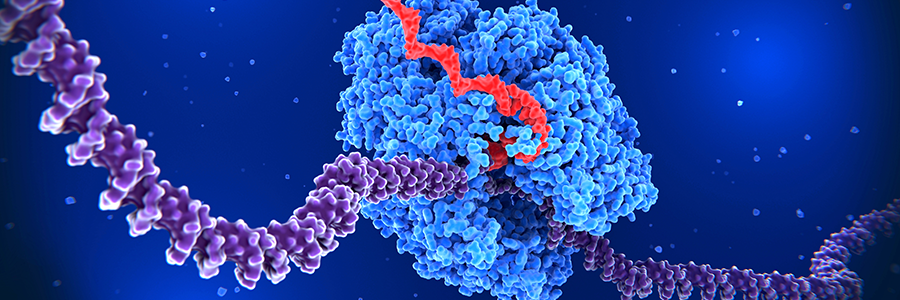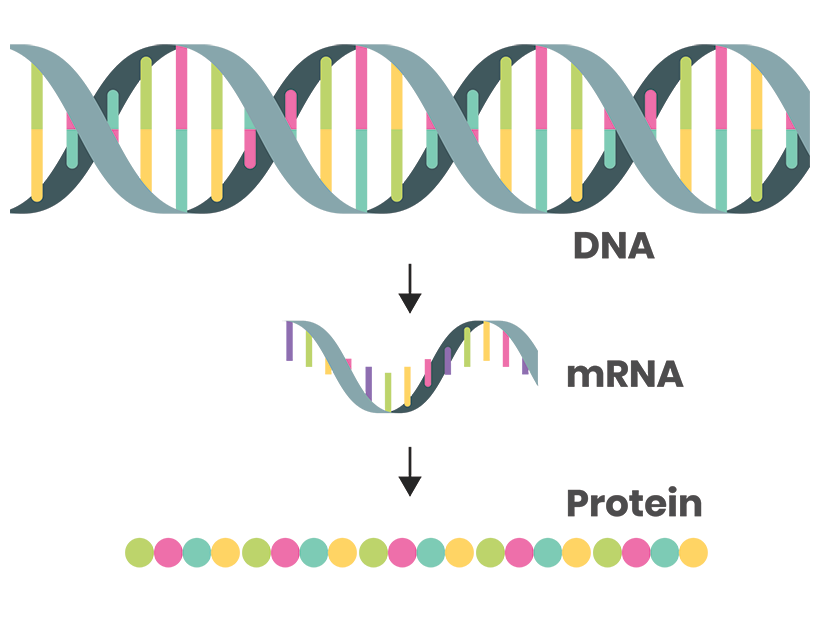The Function of mRNA in Biopharma

Messenger RNA (mRNA) plays a critical role in gene expression, a process in which stored genetic information in DNA is used to create proteins. This RNA molecule acts as an intermediary between the DNA and ribosomes, the cellular structures responsible for synthesizing proteins.
Understanding the function of mRNA can help identify how genetic information is translated into proteins that carry out many functions within cells and organisms. In addition, a knowledge of gene expression can help us understand mRNA’s pivotal role in facilitating the transfer of genetic information from DNA to proteins.
The Role of mRNA in Gene Expression
Gene expression begins with the transcription of DNA into mRNA, a process that takes place in the cell nucleus. mRNA exits the nucleus to enter the cytoplasm, where it binds to ribosomes. These macromolecular elements read the mRNA sequence and use it as a template for protein synthesis.

mRNA molecules are crucial because they carry genetic information from the DNA to the ribosomes. They are essentially copies of DNA segments, but with the bases represented by ribonucleotides instead of deoxynucleotide triphosphates (dNTPs). That allows mRNA to leave the nucleus and travel to the ribosomes, where they are then translated into proteins.
What is mRNA?
mRNA is an essential component of the protein synthesis process in cells that carries genetic information from DNA to ribosomes, which create proteins. mRNA is synthesized during transcription by using a segment of DNA as a template to produce an RNA molecule. This single stranded molecule consists of a sequence of nucleotides including adenine, cytosine, guanine and uracil.
mRNA plays a vital role in gene expression because the sequence of nucleotides in mRNA helps determine a protein's sequence of amino acids. The latter sequence further determines the protein function and shape, which is crucial for biological activity.
Additionally, mRNA is a significant asset in developing new treatments and vaccines. Recently, mRNA has been used to make vaccines, including the Pfizer-BioNTech and Moderna COVID-19 vaccines. These vaccines use mRNA to instruct cells to produce a spike protein found on the surface of the COVID-19 virus. As a result, the body develops an immune response to the virus.
mRNA structure
mRNA’s structure is a single-stranded molecule composed of nucleotides linked by phosphodiester bonds. The nucleotides comprise a nitrogenous base, a ribose sugar and a phosphate group. The nitrogenous bases include adenine (A), guanine (G), cytosine (C), and uracil (U). The uracil replaces thymine (T), which is found in DNA.
The structure of mRNA includes several important features in regulating gene expression. These include the 5' untranslated region (5' UTR), the 3' untranslated region (3' UTR), and the coding region. To begin with, the 5' UTR is located at the beginning of the mRNA molecule and contains the sequence required for translation initiation.
The 3' UTR is found at the end of the mRNA molecule and contains sequences that help regulate mRNA stability and the process of translation termination. This coding region contains the sequence that is translated into a protein.
The structure of mRNA provides the stability required for protein synthesis. However, knowing its functions and examining its role in biopharma is essential.
Functions of mRNA
What is the function of mRNA? Messenger RNA (mRNA) is an RNA molecule type that plays a crucial role in protein synthesis, also known as translation. mRNA carries genetic information from DNA to ribosomes, which are used as a template to assemble the amino acid sequence of a protein. Here are some of mRNA's main functions:
Transcription
DNA is used as a template to synthesize mRNA during transcription. The mRNA molecule is a complementary copy of the DNA sequence, carrying genetic information from the nucleus to the ribosomes in the cytoplasm.
Translation
mRNA provides the template for synthesizing proteins during translation. Ribosomes read the mRNA sequence and use it to assemble a chain of amino acids, which will fold into a specific three-dimensional structure to form a functional protein.
Splicing
In some cases, the primary mRNA transcript undergoes splicing, a process in which non-coding regions (introns) are removed, and the remaining coding regions (exons) are joined together. That allows the production of different protein isoforms from a single gene.
Regulation
mRNA expression is regulated at different levels, including transcription, stability and translation initiation. It allows cells to control the amount and timing of protein synthesis in response to various stimuli.
mRNA Localization
Sometimes, mRNA is transported to specific cell regions and translated locally. It is important for establishing cell polarity and regulating gene expression during development.
Quality Control
Cells have mechanisms to ensure the quality of the mRNA molecules produced. For example, defective mRNAs can be recognized and degraded by the nonsense-mediated decay pathways that can recognize and degrade defective mRNAs.
This is just a glimpse into the functions of mRNA. The macromolecules’ synthesis process undergoes further stages discussed in detail below.
3 stages of mRNA
The process of mRNA synthesis involves three stages: initiation, elongation and termination. The transcription process begins in the initiation stage. After that, the molecule is synthesized in the elongation stage. Finally, the transcription process is stopped in the termination stage.
Initiation
Initiation is the first stage of mRNA synthesis, in which RNA polymerase enzymes bind to the promoter region of the DNA sequence. The promoter region serves as a recognition site for the RNA polymerase and helps begin the transcription process. After the RNA polymerase binds to the promoter region, it unwinds the DNA double helix and transcribes the DNA sequence into an mRNA molecule.
Elongation
The second stage, the elongation of mRNA synthesis, follows the initiation stage. This stage is characterized by the movement of mRNA polymerase along the DNA template strand, where it synthesizes the mRNA molecule.
As the RNA polymerase moves along the DNA strand, it adds nucleotides to the 3' end of the growing mRNA molecule. Additionally, the RNA polymerase proofreads the mRNA molecule to ensure the nucleotides are added correctly.
Termination
Termination is the final stage of mRNA synthesis. In this stage, the RNA polymerase reaches the end of the DNA template strand and stops transcription. For specific microorganisms such as bacteria, termination occurs when the RNA polymerase comes across a termination signal on the DNA sequence that signals the end of the gene.
In eukaryotes, termination is more complex and involves cleavage of the mRNA molecule by specific enzymes, accompanied by the release of the mRNA from the RNA polymerase. The newly synthesized mRNA molecule is then available for translation into protein.
Why is mRNA important?
mRNA is important for several reasons, such as protein synthesis, medical research and vaccines. mRNA has helped revolutionize vaccines, treat genetic diseases, and provides the potential for advanced cancer treatment. These are discussed in detail below:
Revolutionizing Vaccines
mRNA technology has revolutionized the development of vaccines, particularly in the case of the COVID-19 pandemic. This is a remarkable achievement considering that the typical vaccine development timeline is 10-15 years.
Potential for Treating Genetic Diseases
mRNA technology also holds great promise for treating genetic diseases. For example, researchers are investigating the use of mRNA to treat conditions such as cystic fibrosis, Huntington's disease, and muscular dystrophy. These diseases are caused by mutations in specific genes, and mRNA therapy could be used to deliver normal copies of these genes to patients.
Customizable and Scalable
Another advantage of mRNA technology is that it is highly customizable and scalable. This means that researchers can easily modify the mRNA sequence to target different diseases or to optimize the delivery of the mRNA to specific tissues or cells.
Potential for Cancer Treatment
mRNA technology also shows promise in the field of cancer treatment. Researchers are exploring the use of mRNA to stimulate the immune system to attack cancer cells. By encoding specific proteins that are expressed by cancer cells, mRNA can be used to trigger an immune response that targets and destroys the cancer cells.
The role of mRNA in vaccines
The Pfizer-BioNTech and Moderna COVID-19 vaccines were the first mRNA-based vaccines approved for human use. However, the mRNA vaccines had already been in a 30-year development period before COVID-19 vaccines were approved.
These vaccines use a small piece of mRNA that instructs cells to produce a spike protein found on the surface of the SARS-CoV-2 virus. This spike protein triggers an immune response, enabling the body to recognize and fight against the virus if infected in the future.
The development of mRNA-based vaccines has been a significant milestone in biopharmaceuticals. These vaccines represent a new platform for vaccine development that offers several advantages over traditional vaccine platforms. These advantages are discussed below.
Speed of Development
The development of new vaccines can be enhanced through the use of mRNA-based technology. That technology streamlines the production process, as well as provides the ability to quickly modify vaccines to target new or emerging virus strains.
Additionally, the regulatory approval process is also expedited with timely evaluation of safety and efficacy of mRNA-based vaccines through rigorous clinical trials. All of these factors contributed to the rapid development and approval of mRNA-based COVID-19 vaccines during the pandemic.
Flexible Technology
Another advantage of mRNA-based vaccines is their flexibility. The same mRNA technology can be used to target different viruses or cancer cells by altering the mRNA sequence. That means that mRNA-based vaccines have the potential to be rapidly developed and deployed for a wide range of diseases.
Effective Against Autoimmune Diseases
In addition to vaccines, mRNA can also help treat autoimmune and chronic diseases. Research has shown that mRNA can produce proteins that can help regulate the immune system or promote tissue regeneration. It could facilitate the development of new therapies for diseases such as multiple sclerosis, rheumatoid arthritis and heart disease.
The development of mRNA-based vaccines represents a significant breakthrough in biopharmaceuticals. This new platform for vaccine development has the potential to revolutionize the way that vaccines are developed and deployed. In addition, the potential of mRNA as a tool for treating autoimmune and chronic diseases is an exciting area of research that holds promise for the future of medicine.
As a leading provider of products and services for the life sciences industry, Avantor Sciences is committed to supporting the research and development of mRNA and its applications That includes supplying materials and reagents necessary for mRNA synthesis, or developing new technologies to support the production and delivery of mRNA-based therapeutics. Learn more about the products and equipment available from Avantor to support mRNA research here.
Frequently asked questions
Messenger RNA (mRNA) carries genetic information from DNA to ribosomes, where proteins are synthesized. It acts as an intermediary in gene expression, the process by which the genetic information stored in DNA is used to create proteins.
mRNA also regulates gene expression, allowing different mRNA molecules to be produced from the same gene, depending on factors such as cell type and environmental conditions.
The structure of mRNA consists of a single strand of ribonucleotides linked together by phosphodiester bonds. Each ribonucleotide consists of a nitrogenous base (adenine, guanine, cytosine, or uracil), a sugar molecule (ribose) and a phosphate group.
The sequence of nitrogenous bases along the mRNA molecule encodes the genetic information for synthesizing a specific protein. The structure of mRNA is relatively simple compared to that of DNAs double-stranded structure containing deoxyribonucleotides.